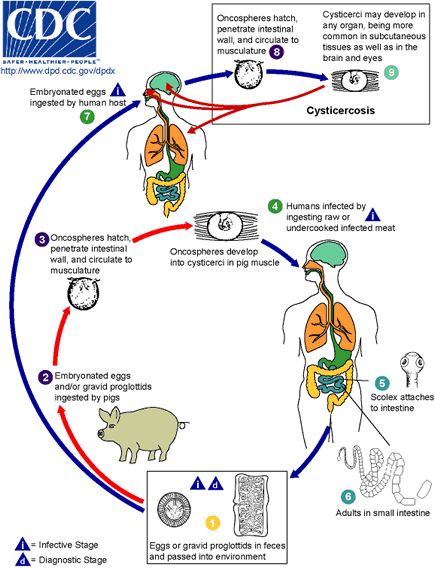Cysticercosis pathophysiology: Difference between revisions
| Line 7: | Line 7: | ||
== Pathophysiology== | == Pathophysiology== | ||
[[Image:Cysticercosis LifeCycle.gif|left|thumb|400px|Life cycle of T. solium with resulting cysticercosis]] | [[Image:Cysticercosis LifeCycle.gif|left|thumb|400px|Life cycle of T. solium with resulting cysticercosis]] | ||
The cestode (tapeworm) Taenia solium (pork tapeworm) is the main cause of human cysticercosis. In addition, the larval stage of other Taenia species (e.g., multiceps, serialis, brauni, taeniaeformis, crassiceps) can infect humans in various sites of localization including the brain, subcutaneous tissue, eye, or liver. | The [[cestode]] (tapeworm) Taenia solium (pork tapeworm) is the main cause of human cysticercosis. In addition, the larval stage of other Taenia species (e.g., multiceps, serialis, brauni, taeniaeformis, crassiceps) can infect humans in various sites of localization including the [[brain]], [[subcutaneous tissue]], [[eye]], or liver. | ||
'''Life Cycle:''' | '''Life Cycle:''' | ||
| Line 17: | Line 17: | ||
Humans are infected either by ingestion of food contaminated with feces, or by autoinfection. In the latter case, a human infected with adult T. solium can ingest [[egg]]s produced by that tapeworm, either through fecal contamination or, possibly, from [[proglottid]]s carried into the stomach by reverse peristalsis. Once eggs are ingested, oncospheres hatch in the intestine '''3''' , '''8''' invade the intestinal wall, and migrate to striated muscles, as well as the brain, liver, and other tissues, where they develop into [[cysticerci]] '''9'''. | Humans are infected either by ingestion of food contaminated with feces, or by autoinfection. In the latter case, a human infected with adult T. solium can ingest [[egg]]s produced by that tapeworm, either through fecal contamination or, possibly, from [[proglottid]]s carried into the stomach by reverse peristalsis. Once eggs are ingested, oncospheres hatch in the intestine '''3''' , '''8''' invade the intestinal wall, and migrate to striated muscles, as well as the brain, liver, and other tissues, where they develop into [[cysticerci]] '''9'''. | ||
In humans, cysts can cause serious sequellae if they localize in the brain, resulting in [neurocysticercosis]]. The parasite life cycle is completed, resulting in human tapeworm infection, when humans ingest undercooked pork containing [[cysticerci]] '''4''' . | In humans, cysts can cause serious sequellae if they localize in the [[brain]], resulting in [neurocysticercosis]]. The parasite life cycle is completed, resulting in human tapeworm infection, when humans ingest undercooked [[pork]] containing [[cysticerci]] '''4''' . | ||
Cysts evaginate and attach to the small intestine by their scolex '''5''' . Adult tapeworms develop, (up to 2 to 7 m in length and produce less than 1000 | Cysts evaginate and attach to the [[small intestine]] by their [[scolex]] '''5''' . Adult tapeworms develop, (up to 2 to 7 m in length and produce less than 1000 [[proglottid]]s, each with approximately 50,000 eggs) and reside in the small intestine for years '''6'''. | ||
==References== | ==References== | ||
Revision as of 14:54, 26 November 2012
|
Cysticercosis Microchapters |
|
Diagnosis |
|---|
|
Treatment |
|
Case Studies |
|
Cysticercosis pathophysiology On the Web |
|
American Roentgen Ray Society Images of Cysticercosis pathophysiology |
|
Risk calculators and risk factors for Cysticercosis pathophysiology |
Editor-In-Chief: C. Michael Gibson, M.S., M.D. [1]
Overview
Pathophysiology

The cestode (tapeworm) Taenia solium (pork tapeworm) is the main cause of human cysticercosis. In addition, the larval stage of other Taenia species (e.g., multiceps, serialis, brauni, taeniaeformis, crassiceps) can infect humans in various sites of localization including the brain, subcutaneous tissue, eye, or liver.
Life Cycle:
Cysticercosis is an infection of both humans and pigs with the larval stages of the parasitic cestode, Taenia solium.
This infection is caused by ingestion of eggs shed in the feces of a human tapeworm carrier 1 . Pigs and humans become infected by ingesting eggs or gravid proglottids 2 , 7 .
Humans are infected either by ingestion of food contaminated with feces, or by autoinfection. In the latter case, a human infected with adult T. solium can ingest eggs produced by that tapeworm, either through fecal contamination or, possibly, from proglottids carried into the stomach by reverse peristalsis. Once eggs are ingested, oncospheres hatch in the intestine 3 , 8 invade the intestinal wall, and migrate to striated muscles, as well as the brain, liver, and other tissues, where they develop into cysticerci 9.
In humans, cysts can cause serious sequellae if they localize in the brain, resulting in [neurocysticercosis]]. The parasite life cycle is completed, resulting in human tapeworm infection, when humans ingest undercooked pork containing cysticerci 4 .
Cysts evaginate and attach to the small intestine by their scolex 5 . Adult tapeworms develop, (up to 2 to 7 m in length and produce less than 1000 proglottids, each with approximately 50,000 eggs) and reside in the small intestine for years 6.